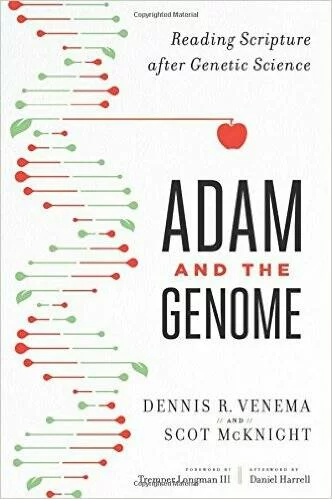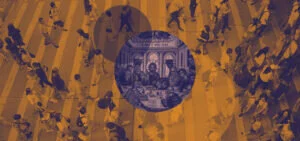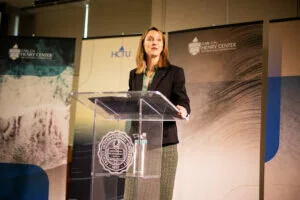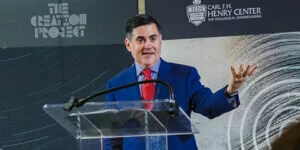I am grateful to Dennis Venema and Scot McKnight for their work in Adam and the Genome, and I am also thankful for the engagement provided by the scholars who have contributed to this symposium. This conversation is exactly the sort of forthright, well-informed, and charitable discussion that the church needs, and it is just the sort of thing that the Creation Project seeks to encourage.
The Conversation
The issues raised in Adam and the Genome are both fascinating and important. In it, the authors do a splendid job of summarizing the conclusions of contemporary research in genetic science. The account is clear and readable, and it provides non-specialists (like this theologian) with an understandable and lucid overview of recent work. This is no easy task (at least for this theologian!), and the book does it well. The book also raises some important theological issues and questions that are related to the scientific work, and it urges us to take these issues seriously. For these reasons, Adam and the Genome makes a very valuable contribution, and Christians who care about such matters stand in their debt.
The book presses us to take the theological issues seriously, and this is just what our contributors do. Not all of our scientists are completely persuaded by, or fully content with, the discussion of the science; Jitse van der Meer offers some friendly amendments to the case laid out in the book, Faz Rana suggests a different possible interpretation of the scientific data, and Joshua Swamidass gently chides Adam and the Genome for some critical omissions. Nonetheless, most of the interest seems to be related to the theological issues. Thus Darrell Bock raises some challenges to the notion that the Adam of the New Testament is only a “literary Adam” or “archetypal Adam” rather than a historical figure to whom all humans are related in a crucial way. He argues that the best reading of Scripture leaves us with the conclusion that Adam is both an archetype and a historical figure, and he concludes that we should not rip asunder what the Bible joins together. Similarly, Elizabeth Sung raises methodological and substantive concerns that are theological in nature. Interestingly, the scientists also raise matters of theological interest. For instance, Rana is concerned with methodological naturalism, van der Meer advocates (on exegetical and theological grounds) for something stronger than a mere literary Adam (while resisting the idea that the Bible is making claims about biology and genetics), and Swamidass focuses on Christological concerns in his engagement. Moreover, the heart of Venema’s critical rejoinder to Swamidass is distinctly theological, as he finds the idea that there were humans who were not in the image of God to be nothing short of “horrific.”
The Central Question
The central issue in Adam and the Genome is the “historical Adam.” Christians have traditionally believed that all humans are descended from an initial ancestral pair and are related to them in a theologically important way, and they often are convinced that this belief is warranted by biblical revelation. Is this belief still tenable in the light of contemporary science? Or do the findings of the Human Genome Project rule out belief in a historical Adam? Such questions animate both the book and the conversation, and they deserve serious consideration. In light of what we’ve seen, what should we conclude?
Adam and the Genome makes an eloquent case for two claims that are key to this discussion. First, the book defends what we might call the “Common Ancestry Thesis;” this is the view that humans and other primates share a common ancestry that is indicated by both morphological evidence and genomic sequence data.Christians have traditionally believed that all humans are descended from an initial ancestral pair and are related to them in a theologically important way, and they often are convinced that this belief is warranted by biblical revelation. Second, the book makes a case for what we can refer to as the “Large Initial Population Thesis;” roughly, the view that the initial human population would have had to evolve as a group, and that the first community of (anatomically modern) humans would have been several thousand in number. It might seem that these theses are inconsistent with belief in a historical Adam; it might seem that the science contradicts the claims of Scripture (at least as traditionally interpreted). Indeed, it might seem that the inconsistency is obvious, and it might seem that the only responsible (Christian) thing to do is to look for an interpretation of Scripture that does not demand a historical Adam. The options are simple and binary: either a historical Adam or contemporary genetic science.
It might seem that this is the way things are. But this is the point at which this symposium is so helpful, for we are now in a position to see that such a conclusion would be hasty and unfortunate. To see this, it might be helpful for us to take a step back and consider what it means to say that two claims are contradictory or inconsistent. Two propositions are inconsistent if they cannot both be true. If they are contrary to one another, then they cannot both be true; if one is true, then the other must be false (but both could be false). If they are contradictory, then it is not possible for both of them to be true, but one of them must be true (it is not possible that both are false). So is belief in a historical Adam inconsistent with belief in the Common Ancestry Thesis and the Large Initial Population Thesis? Actually, it is not inconsistent; these are neither contrary nor contradictory. For so long as it is possible for both to be true, then the affirmation of one does not require the negation of the other. And–as the symposium shows–in point of fact it is possible for both to be true.
Swamidass offers one possible way of holding to both, and it is interesting to note that Venema admits that this is indeed possible; it is even more interesting to note that Venema’s rejoinder to it is distinctly theological. Venema’s criticisms deserve serious consideration, but the crucial point here is that he raises no scientific objections to the proposal. But Swamidass’s approach is not the only possibility here. Indeed, possible scenarios abound; scholars as diverse as C. S. Lewis, John Stott, Denis Alexander, and N. T. Wright have proffered theories. These theories have not been ruled out or shown to be untenable (it is unfortunate that some of these are only briefly mentioned and then summarily dismissed as “concordist”. . . and with a definition of “concordism” that can hardly be considered appropriate to the positions in view). The bottom line is this: so long as it is possible for both (the conjunction of the Large Initial Population Thesis and the Common Ancestry Thesis with belief in a historical Adam) to be true, then we should not conclude that one rules out the other. And it is possible that both are true,It is also important to consider how biblically-grounded claims to revealed truth might “press in” on scientifically- informed claims. so there is no reason for people who think that both the scientific claims and the theological claims are justified to feel pressure to reject one in favor of the other. There is a lot of room to grow in our understanding, and there is much that is mysterious. But there is no contradiction.
So where does this leave us? Perhaps surprisingly, it leaves us with the conclusion that one need not reject belief in a historical Adam in order to affirm contemporary genetic science. And, of course, it leaves us with the conclusion that one need not reject the science in order to hold to belief in a historical Adam. Some Christians likely will hold the “Common Ancestry Thesis” and the “Large Initial Human Population Thesis” at arm’s length for other reasons (theological or otherwise), but they should not do so on the grounds that these theses are inconsistent with belief in a historical Adam. Others may dismiss commitment to a historical Adam for various reasons, but they need not do so on the motivation that this historic Christian belief is ruled out by the science. For those of us who remain convinced that belief in a historical Adam is scripturally warranted and theologically important, there is no reason to reject or fear the science.
Further Considerations
Along the way, Adam and the Genome (and the subsequent conversation) raises several other issues of theological importance. The meaning of the doctrine of original sin–and its relation to both the contemporary scientific discussion and the biblical-theological foundation–is crucial (unfortunately, the book’s discussion of “the sin nature” and “sin natures” fails to connect with historic Christian teaching and only serves to muddy the waters that are already very deep).For an account of original sin that interacts with historic Christian positions, see Oliver D. Crisp, “On Original Sin,” International Journal of Systematic Theology 17, no. 3 (July 1, 2015): 252–66. See also Thomas H. McCall, Against God and Nature: The Doctrine of Sin, Foundations of Evangelical Theology (Wheaton IL, Crossway, forthcoming). Discussion of “concordism” would benefit from further clarification. And the more general issue of what counts as “magisterial” in these conversations also warrants more investigation. Much of this discussion has proceeded along the lines of “scientific claims pressing in on traditional theology,” but it is also important to consider how biblically-grounded claims to revealed truth might “press in” on scientifically- informed claims. Such questions as these give us ample work to do, and the Creation Project looks forward to doing such work with all the energy and confidence that comes from the conviction that we belong to God and can trust his revelation to us. And as we move forward, we do so with deep gratitude to the authors of Adam and the Genome and the contributors to this symposium.








Comments
Be the first one to make a comment!